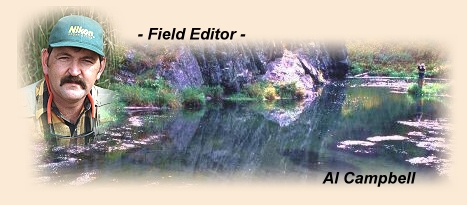|
From humble beginnings near O'Neil Pass on US
Highway 85, Spearfish Creek flows northeastward
then northward through the northwestern corner
of Black Hills of South Dakota. This is historic
gold mining country. In fact, portions of this
stream flow within ten miles of the gold boomtown
of Deadwood where Wild Bill Hickock lived, gambled
and met his fate. Today, Deadwood mines gold from
tourists with its legal gambling, including slot
machines and casinos that line Main Street. However,
fishermen are more likely to mine a little gold in
the form of brookies, brown and rainbow trout that
inhabit the streams of the Black Hills.
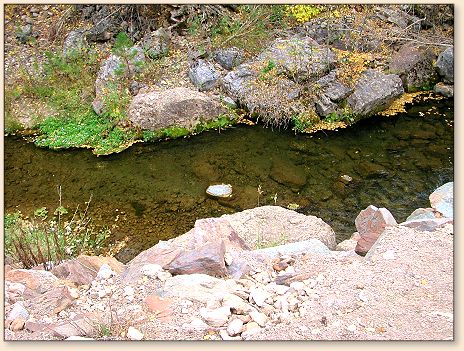
From its beginnings to its junction with Hanna Creek
(east fork of Spearfish Creek), the stream runs
parallel to US Highway 85; so access is as easy
as pulling off the side of the road. Truly a
spring creek in nature, this portion of the stream
is full of brookies with an occasional brown trout
thrown in for good measure. If size isn't a concern,
but non-stop action is, this is the place to fish.
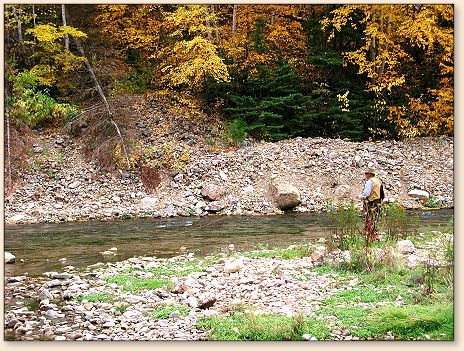
From Cheyenne Crossing where Hanna Creek joins the
flow, Spearfish Creek turns northward and follows US
Highway 14A. Registered as a National Forest Scenic
Byway, it's a spectacular drive with abundant parking
areas and pull-offs that allow complete access to the
water. If you're not careful, you might find yourself
getting lost in the beauty of the towering cliffs and
emerald pines just long enough to miss the rainbow
trout that inhaled your fly. This is especially true
in autumn when the trees are at the height of their
color.
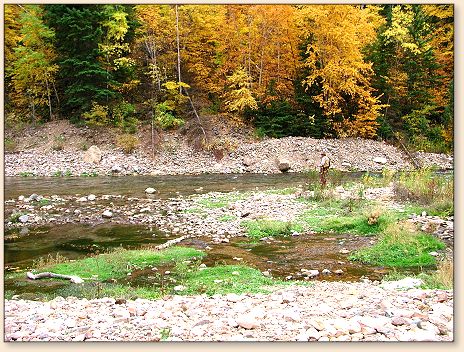
Brown and brook trout dominate the portions of the
stream, from Cheyenne Crossing to Savoy. This is
gentle water that wanders through grassy meadows
and occasional beaver ponds. If you want to battle
a tackle testing brown or brookie, try casting a
small nymph into the catch and release waters of
Yates Ponds north of Cheyenne Crossing. The fish
in these ponds are shy and selective, but big enough
to thrill the most experienced fly caster. Bait
fishermen will be disappointed when they see the
signs near these ponds; they are restricted to the
use of artificial lures, and no bait is allowed
within 100 feet of either pond.
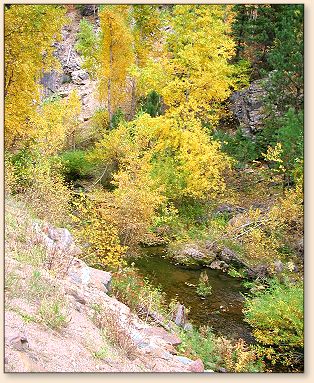
Much of the stream's water is removed near Savoy
and piped to the Homestake Mining Company's
hydroelectric plant near Maurice. Spearfish Creek
between these two points is small and slow and the
fish hold in the deepest pools. Brown trout and
small rainbows are the prime offerings here,
especially where Little Spearfish Creek and Iron
Creek empty into the stream. A journey up either
of these feeder streams will provide some excellent
fishing for brookies in the six to twelve inch class.
A size 14 Royal Wulff or Adams is a good bet for
some fast summer action.
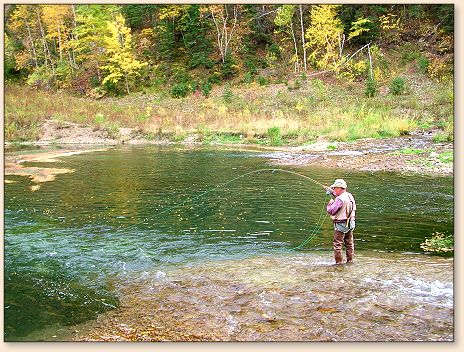
From the Homestake hydroelectric plant downstream
to Maurice Intake Dam #1, rainbow trout are the
dominant species. Eight to fourteen inch fish are
the average, but fish to several pounds can be caught.
This is fast water with prolific hatches of aquatic
insects throughout the year. Fish the stream's edges
and swirls behind rocks and points for the best
results. This portion of Spearfish Creek is the
only place in the Black Hills where rainbow trout
naturally reproduce on a regular basis. All rainbows
in this stretch of water must be released and bait
is strictly prohibited. Of course, this results
in more and bigger rainbows for us to catch and
that's why we fish, isn't it?
Most of the water is removed from the natural
streambed at Maurice Intake Dam #1 and piped
directly into the town of Spearfish. This is
due to several large sinkholes in the streambed
that effectively de-water Spearfish Creek downstream
from the intake dam. Rerouting the water results
in steady water flows in the town of Spearfish and
northward for about 20 miles to its junction with
the Redwater River.
Fishing in the town of Spearfish is excellent.
The trout are abundant and less spooky since they
don't get a lot of fishing pressure. Access in town
is easy, and you aren't likely to have a lot of
competition from other anglers. I'll probably never
fully understand why people who claim they just want
to catch fish would shy away from a resource like
this because the setting isn't what they envision
for a trout stream.
When Spearfish Creek leaves the town of Spearfish,
it enters private land for the remainder of its
journey to the Redwater River. Access is very
limited, but those who are lucky enough to know
a landowner that will grant fishing permission
are treated to some excellent fishing, especially
in late summer when hoppers are abundant.
Insect hatches on Spearfish Creek are often heavy.
Caddis hatches are heavier in this creek than anywhere
else in the Black Hills, and the fish are more than
willing to feed on insects. The Yellow Sally stonefly
hatches in June and July are strong and reliable.
Midges hatch all year and keep the fishing temptation
alive even during the winter. Like the rest of the
streams in the Black Hills, Spearfish Creek is open
to fishing all year, so winter fishing is fairly
common.
Unlike many other streams in the Black Hills, Spearfish
Creek isn't likely to dry up during a drought. Last
year when so many streams went completely dry in their
lower stretches, Spearfish Creek had nearly normal
flows and provided excellent fishing all summer.
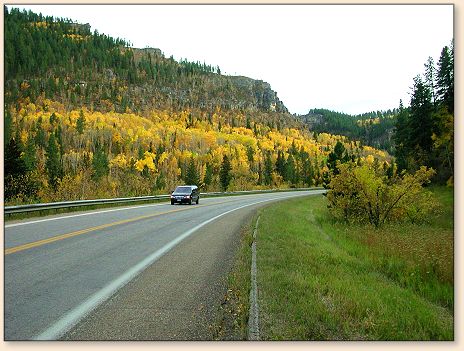
No fishing excursion to the Black Hills would be
complete without a visit to the hungry fish that
inhabit Spearfish Canyon. If the fish don't capture
your heart, the scenery and history of this place
will. Either way, it'll be a treat you won't easily
forget.
~ AC
|
